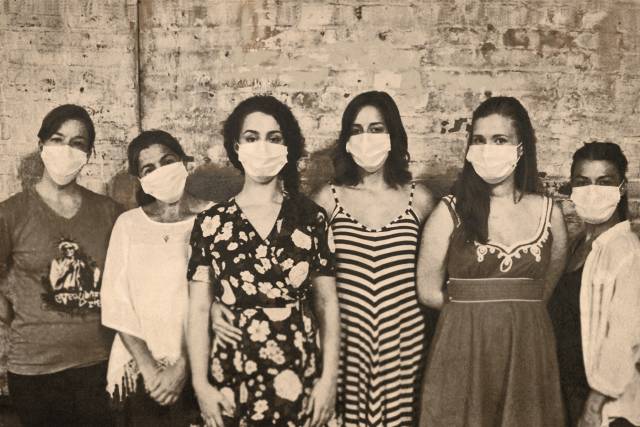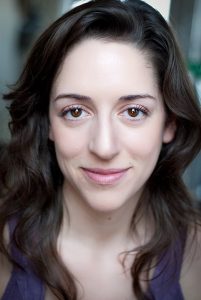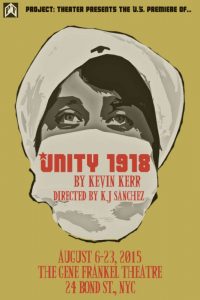
 It seems apropos to meet up with dedicated theater artists Jessi Blue Gormezano and KJ Sanchez in a slightly battered second floor theater space off of 10th Avenue on 52nd Street; the kind of space that is fast disappearing as the Hell’s Kitchen neighborhood continues to be gentrified. Ms. Gormezano is the associate artistic director of Project: Theater, which is producing Unity (1918) by Kevin Kerr, as well as part of the cast; the play is directed by Ms. Sanchez. A long day of rehearsing in this space has concluded, and weariness is coupled with excitement as Ms. Gormezano calls down from the second floor stairwell urging me to walk instead of using the dicey freight elevator and informs me that they have just found the end of the play today. Sitting down in a creatively messy room I am intrigued to find out more about this Canadian play having its U.S. premiere and how these two woman, who possess equal amounts of moxie and passion, create unique theater.
It seems apropos to meet up with dedicated theater artists Jessi Blue Gormezano and KJ Sanchez in a slightly battered second floor theater space off of 10th Avenue on 52nd Street; the kind of space that is fast disappearing as the Hell’s Kitchen neighborhood continues to be gentrified. Ms. Gormezano is the associate artistic director of Project: Theater, which is producing Unity (1918) by Kevin Kerr, as well as part of the cast; the play is directed by Ms. Sanchez. A long day of rehearsing in this space has concluded, and weariness is coupled with excitement as Ms. Gormezano calls down from the second floor stairwell urging me to walk instead of using the dicey freight elevator and informs me that they have just found the end of the play today. Sitting down in a creatively messy room I am intrigued to find out more about this Canadian play having its U.S. premiere and how these two woman, who possess equal amounts of moxie and passion, create unique theater.
I have a fascination with World War I. 1918 was such an incredible time in history with so many world changing events. This play Unity (1918) by Kevin Kerr takes place in the small town of Unity, Saskatchewan and is an epic chronicle grappling with the ravages of World War I and the devastation of the 1918 influenza pandemic aka the “Spanish Flu”, which killed 50 million people; some statistics say it could be as high as 100 million. What is it that attracted you both to this play? What do you feel is the significance of this play to our world today?
KJ Sanchez: This is a play I’ve wanted to direct for ten years. It’s never been done in the U.S. and we are doing the premiere. What attracted me to the play is that it has everything that I love about theater. And I know these are such overused terms, I completely realize that, but I mean them. Don’t you just want to hold up a sign and say, “No, but for real, this time I mean it!” The play’s got so much humanity, a great combination of really dark and really funny stuff, it’s very theatrical, super playful and can be sincere, witty, snarky and romantic all at the same time. You know, sometimes I worry that we can easily get into a rut. We have little silos of different kinds of theater, “smart people saying really mean things to each other” plays or “we’re noncommittal young kids shrugging our shoulders but have a lot of worries on our minds” plays. And one of the things that I liked about this play is that it broke across all those familiar genres. The playwright effortlessly toggles back and forth from pathos to …
Jessi Blue Gormezano: Farcical.
KJ: Yes, farcical humor. And I too have always been interested in the World War I time period, the impact it has had on our culture and how it has shaped the world. Do you know about the monster movies of each era? After WWI you had Frankenstein movies because men were coming back in pieces, missing body parts. And then you start to read about the 1918 influenza. The research says that the flu killed five percent of the world’s population.
JBG: Gone. In a matter of a month and a half.

KJ: And it killed the healthiest people. Of course there are the political connections to world health issues and people coming back from wars, which has clearly been on our minds right now. But you know what’s so funny? All these thoughts that I just said came after I fell in love with the play. I was lucky enough to see the play in Vancouver, so all my other passionate connections came after I knew I wanted to do this play. It just so happens that they all fit together.
And I knew I wanted to work with Jessi’s company, Project: Theater. Jessi and I first met at the Asolo Theatre in Sarasota and I cast her in my theater piece, ReEntry, which she’s done for many years. I’ve become a fan of their company, love their style, the way they move through the world, their musical sensibilities and the way they produce work. So I brought them Unity (1918). The play can be done in a very expensive way. It’s a cast of nine. But of course that kind of budget didn’t exist. So we all just worked together to make it happen. And it’s exactly what I needed. I am so happy working on this. It reminded me of why I got into theater in the first place, it’s about invention.
JBG: When I read this script I had so many feelings, it made me wanted to dig deeper and explore. The text is beautiful, unsentimental, rich and fertile. It wasn’t one of those plays where you say, “Oh I get it.” And I had no idea how it would work on stage. But I trusted KJ and the people who I put into these roles and it’s been incredible to watch the invention that KJ talks about happen with everyone in rehearsal. It’s been a joy.
KJ: What I love about Kevin [Kerr]’s writing is that even though there is so much interesting research that goes into the play, he’s never showing off the research he’s done. And then there are these little details. Like there is a song played off stage, à la those moments in a Chekhov play. There’s this Ukrainian funeral song and once you start doing the research, you learn that there were these Ukrainian migrants that settled in Unity at this time. You just fall into a world of fascination.
I love that turn of phrase – fall into a world of fascination! There are so many great plays by Canadian playwrights. Kevin Kerr, Stewart Lemoine, Michel Tremblay, Brad Fraser, Ann-Marie MacDonald, the novelist Carol Shields……what are your thoughts on why there aren’t more productions and recognition of Canadian playwrights? We might not find the answers but it would be good to discuss!
KJ: Yeah! I don’t know. It’s such a great question that I just don’t have the answer to. I mean, more and more we see Mexican plays being done.
JBG: Maybe we write it off as we (Americans and Canadians) are pretty much the same. I don’t know. Perhaps we think, what do they have to offer that is unique and distinct that we couldn’t create here? The fact is, a lot!
KJ: Huge things. Two big contrasts between the US and Canada are, one they never had slavery and they were never a melting pot. I was teaching at the University of British Columbia for a few years and one of my Canadian colleagues said, “We aren’t a melting pot, we are mosaic.” Race relationships are very different. Person A is not forcing Person B to melt.
A mosaic is distinct.
KJ: Yes, you can have your distinct history, background, culture without losing it into a pot of brown goo.
JBG: It is very easy to go down the well-trodden programming path as a producer. But to take a chance and say let’s explore this country that’s right next door is risk taking.
KJ: And they have a strong tradition of theatricality. The theater I’ve seen in Canada is bold, not so rooted in realism. And something that playwright Kevin Kerr said is that he sees his role as a playwright to invent something new for the form. That kind of adventurous spirit -- I dig it!
JBG: I feel this play has woken me up to so many other worlds of theater making that I didn’t know.
KJ: Also, what this play did for me was to understand the role that Canada played in World War I, how hard they were hit by the pandemic and how these two events shaped the Canadian identity. It was the young women who were caring for the sick and burying the dead. Which is another thing I love about this play. Six woman keeping everything going! And being left alone to rebuild the country.

What is the creative process for director and actor to authentically create this play?
JBG: There is no safe neutral place in this play. If you think you can say I’m just going to walk and be safe in the center, it’s not going to work. The direction that KJ has given us is “Nothing’s over and it’s not okay”. Which makes you laugh and cry at the same time, which is what this play does. Lots of gallows humor.
KJ: We were lucky that we had the workshop last year, so research has been going for a year. We’ve filled our minds and imaginations with as much as possible. My job as a director is to nurture the gallows humor; to think about how to acknowledge that era when we are on a shoestring budget with no set changes. We have over 40 scenes in many locations, performing in the tiny Gene Frankel Theater. We have a select number of authentic props that speak to that world and we’ve emotionally and physically invested in. How do we piece together this world using only a handful of puzzle pieces? The building of the show has been like we are archeologists and we are on a dig.
JBG: Plus the scenes are so short, we have to make transitions fast and engage the audience’s imagination quickly. A prop, like a bucket is one thing and suddenly becomes something else a few moments later. We have to move on and let it go constantly, which creates surprise for the audience.
KJ: The cast collectively are the sound designers. So if you are not in a scene you are in the corners of the room creating live sound for the scene.
JBG: Everyone is always doing something!
KJ: If the script calls for the sound of a thresher, we’re using a pipe, a metal gel frame, a paint can and a bag of corn!
KJ and JBG: (Laughter)
JBG: Everything is a collaborative process. KJ might throw an idea out and then we contribute to it. And in the end something else has evolved.
KJ: Something better!
JBG: Everyone respects each other enough to take an idea and say yes! That has permeated throughout the rehearsal process because of KJ’s trust in us and opening it up to us to contribute. Not all directors are like that, some say “Here, execute my vision.” And then do it better!
KJ: It’s fun! Because I am also directing actors who are also directors--
JBG: And writers--
KJ: And I don’t feel intimidated. We’ve set aside hierarchies and just listen to what the play needs. It’s really a good shot in the arm. These are all the reasons why we do theater.
JBG: You get that sense of successfully inventing; you’ve just built something together, in the moment and you feel it hit that sweet spot!
Your audience gets to sit back and enjoy all this collective, collaborative imagination work.
JBG: And add to it!
As devoted theater artists who are constantly developing new material and getting the work seen, can you address the rewards and pitfalls of wearing several hats simultaneously – actor/producer, director/writer of a piece of theater.
JBG: Wearing the producer hat – it’s about picking the best people to be part of the team and then trusting them to do what they do. And then do everything you can to nurture them. And learn to let go of things! What’s been so great with this team for Unity is that it’s like getting on a sail boat and letting the wind take us.
KJ: You and Joe Jung are such great producers!
JBG: Plus learn how to take the producer hat off and just be an actor. A pitfall is that I probably don’t sleep enough! A reward is that I like the challenge of doing different things, sort of like my character Bea in Unity (1918).
KJ: Another weird thing is that I’ve never met a cast that owns so many bizarre random objects. One of our actresses had a wind machine at home! We’re using it! I like wearing different hats and I love working collaboratively, you have to think in a way that is very expansive. I’m not a big fan of the conveyor belt with everyone in their own little worlds. I thrive when all the stuff is thrown into the room at once. After a collaborative rehearsal I feel like I’ve done a crossword puzzle and had a good run. I firmly believe that there is a genius only found in a group and the genius is in fact bigger than the sum of all its parts.
 Jessi, what are your dream roles or dream plays to produce/direct and KJ what are your dream plays to direct or dream themes you’d like to wrap yourself around as a playwright?
Jessi, what are your dream roles or dream plays to produce/direct and KJ what are your dream plays to direct or dream themes you’d like to wrap yourself around as a playwright?
JBG: As a producer/director, Oscar Wilde’s Salome. I think the whole story is fascinating and love that the action all happens in one crazy night. A shot out of the gate. In terms of roles, I remember reading O’Neill’s Touch of a Poet and love the role of Sara, she’s trying to hold it all together. I like roles when a woman is being asked to do more than she can do and then seeing whether they succeed or fail. And I want to act in a Lisa D’Amour play. I love her writing so much.
KJ: I want to direct a Burning Man Midsummer Night’s Dream. Maybe on location! Because I have a tendency to direct my own stuff, I really want to work more with living playwrights who are in the room for the rehearsal process, like Kevin Kerr and Matt Smart. Also Kris Diaz and Martín Zimmerman. And in terms of themes, Cuba! It’s opening up, what’s going to happen, how do you go back? It’s been swirling around inside and now’s the time!
Finally, if you could have dinner with a theater artist – dead or alive – who would it be and what would you talk about?
JBG: I would like to eat a meat and cheese plate with Peter Brook, sit outside with him, and suddenly know how to speak French; conversing with him about whatever he is working on at the moment. Love him.
KJ: I’m never good at those questions, I might have to pass. No wait, here’s my answer. I would want to have dinner with Jessi (laughter), take her to the best restaurant in New York and have a five hour dinner.
Project: Theater presents the US premiere of UNITY (1918), written by Kevin Kerr and directed by KJ Sanchez. UNITY (1918) begins performances on Thursday, August 6 for a limited engagement through Sunday, August 23. Press opening is Sunday, August 9 at 7 PM. The performance schedule is Wednesday - Friday at 8 PM; Saturday at 2 PM and 8 PM; and Sunday at 2 PM. (Please note there are no matinee performances on Sunday, August 9 and Saturday, August 15.) Performances are at The Gene Frankel Theatre (24 Bond Street at Lafayette). Tickets are $18. Tickets are available by calling Smartix at (212) 868-4444 or online at www.smarttix.com. For more information, visit www.projecttheater.org.
UNITY (1918) begins performances on Thursday, August 6 at the Gene Frankel Theatre for a limited engagement through Sunday, August 23.